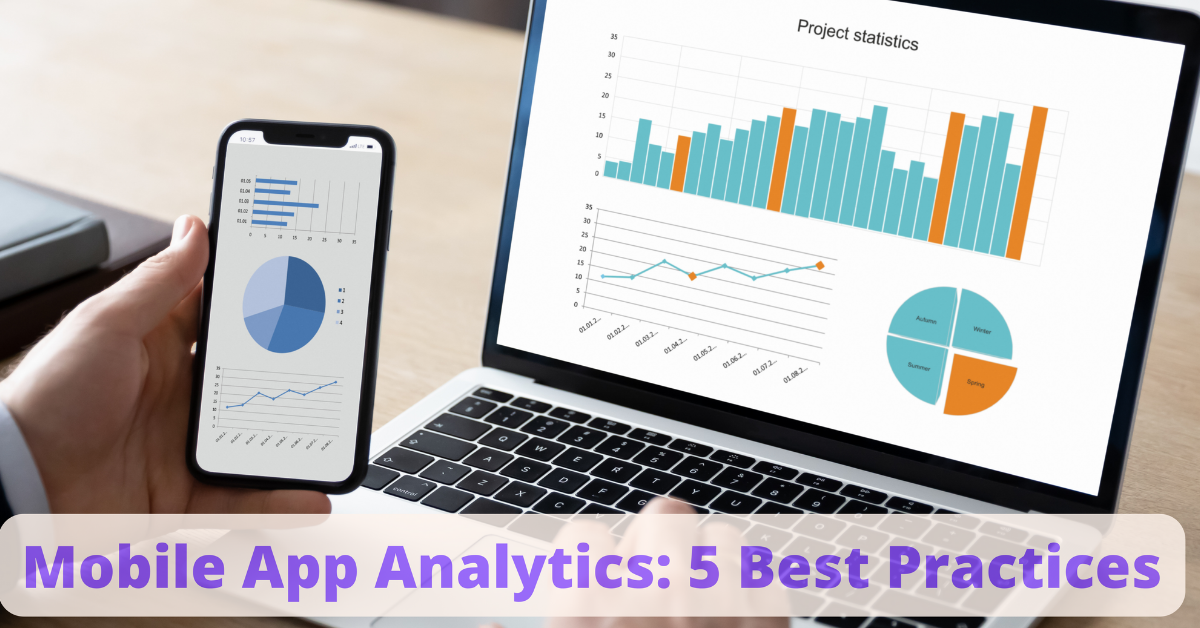Mobile App Analytics: 5 Best Practices

Mobile app analytics is a developer’s best friend. Without it, you would be trying different things blindly without any data to support your mobile app development. Mobile app analytics helps in understanding how users behave and how the app can be optimized in order to achieve your goals.
To track their progress, developers ought to understand the mobile app analytics while working towards achieving their goals.
Why Mobile App Analytics?
Mobile app analytics is essential to the development process. It gives insights into how users are using the app, which area of the app users are interacting with, and what efforts they take in the app.
These insights will then help in developing an action plan to improve the product further, like adding new elements that the users seem to need, enhancing existing features to make the user’s lives easier, or pulling out parts that the users don’t seem to utilize.
On the other hand, it will allow the developers to understand whether the app is achieving its goals for the mobile app. Whether it is revenue, awareness, or other KPIs, use the data to adjust the strategy and optimize the app to achieve the goals.
What Are The Mobile App Goals?
To know how to use the mobile app analytics to reach the goal, one needs to understand the purpose first. Different apps have different goals and different targets, depending on the app.
For instance, online mobile gaming usually maximizes revenue by growing its user base and pushing for in-app purchases. Whereas, the aim of the retail apps could be to increase traffic at the store and boost brand awareness. Other video and music-based streaming apps may seek to get their users to subscribe to their apps monthly or annually.
It highly hinges on what you want from the mobile app and why it was built in the first place. Mobile app analytics are vital to reaching your goals.
Analyze the app by paying attention to the following points:
Creating a mobile app is only half the battle; after that, it’s time to optimize your mobile app and monitor the behavior of your app users consistently. The competition is intense, with over 6.64 billion smartphone users and over 3 million apps worldwide. Mobile app businesses have to remain vigilant and offer their customers an excellent mobile app experience, and it can only happen with the help of mobile app analytics.
-
Determine User Journey
Mobile App analysis is critical. Tracking the user journey is very necessary for app development and later marketing. In fast, the visitor’s journey should be reviewed after each visit on the mobile app.
It is essential for mobile app marketing that we understand who the app users are and how was their journey through the app. Thus, learning what the users are doing in the app will define a better user journey.
Analyzing the mobile app users’ journey will let us know what they are looking for in your app, their intent, and the area that receives the highest hits or gives the most business. Knowing the app’s user journey information can help maximize the conversion rate.
How to guide a user to the purchasing phase? It is crucial to define the steps in this journey; you can follow the suitable events and start learning where users leave. This way, you can optimize your user journey and increase revenue.
-
Test The App
It is essential to examine the mobile app performance for every user, and app testing should also be conducted on different devices. It will help in performance analysis and in gaining user satisfaction.
There are hundreds of Android devices on the market. You can’t test your app on all of them — but you should test your app on small, medium, and large-sized Android phones. And if your app is working great on one device, it doesn’t guarantee that it’ll work on all others.
Testing, again and again, will better your app performance and help hit your goals and enhance your brand’s reputation.
-
Do A/B Testing
Creating a mobile app is one of the initial steps in marketing. Once you are done with the design and users’ journey, you will have to figure out the tactics to help raise conversions.
That’s where A/B testing can help.
Use A/B testing to optimize the conversion rates of your funnel. A/B testing is the most helpful way to test the effects of a change in users’ journey. This allows the developer to isolate a discrepancy, compare it with a group, and gain insight and confidence in your results before implementing it.
-
Put Money Into Qualitative Data
Invest in qualitative data to research through the information collected from the users’ movement on the mobile app. Ask questions and take surveys to get supporting data. Collect data as users interact with the app, learn how and why they perform specific actions in the app.
By extracting data from such interactions, you can reach valuable results. User ratings are integral to the app’s success, but please remember that everyone will see this rating on the app store. There are no more reasonable ways to determine how users use your app than to ask them directly.
It can be achieved by sending them an in-app message at a good time. Let the user know that their feedback is welcomed and that you see them as an opportunity to improve functions in your app.
-
Use Industry Benchmarks
Industry benchmarks are a valuable way to measure how the app is performing. Standard industry benchmarks can provide insights into user behavior before installation and later in-app engagement analytics.
The data can be filtered by region, platform, vertical, and type of acquisition. It is important to look at industry benchmarks per vertical as users’ behavior will vary depending on the app’s function.
There are countless reports on different analytics that you can use according to your priorities. It will assist in determining which element of the app should get focused on or improved to stay ahead in the market.
Conclusion
Mobile app analytics are incredibly helpful in telling everything you need to know about your app — how it is being used, what is working for your app, and what doesn’t. If appropriately utilized, it can help you reach your goals and take your app to new dimensions.
Building a regular userbase for the mobile app is challenging and takes time. We hope that the best practices mentioned in this article will make things easier for you.




